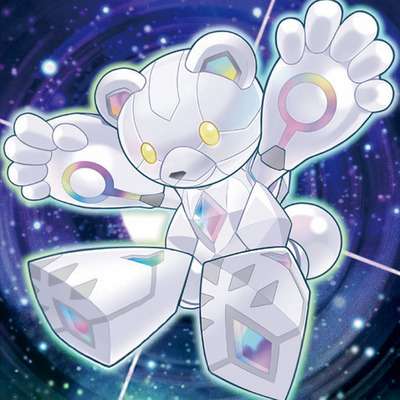Introduction
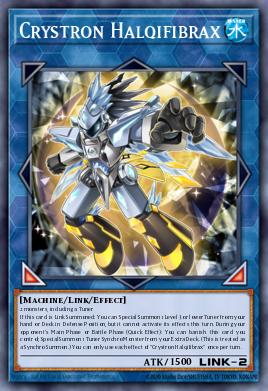
Today I'd like to introduce (and remind) many of you of a theme that has largely fallen by the wayside since its intial debut nearly eight years ago - Crystron. This deck holds a special place in my heart as it's one I experimented with a great deal with at locals over the years, with little success.
This will be a short piece covering the theme, the potential it could have in future, and what could be done to alleviate the issues with the deck.
What are Crystrons?
Crystrons are a theme of water-attribute machine monsters, first introduced in Yu-Gi-Oh!'s Invasion: Vengeance (INOV) core booster set, released in the TCG in November of 2016. Crystrons are one of several archetypes that lead into one of the waves of "Dracoslayer" lore - its compatriots being Metalfoes, Zoodiac, and later True Draco/King tying the archetype's stories together. Unlike its compatriots, Crystrons were the only theme at their time of release not to have a large impact on the overall metagame. Metalfoes variants dominated the meta for several months, while Zoodiac and True Draco famously ushered in one of Yu-Gi-Oh!'s longest tier zero formats. 
Pictured: "Crystron Quan", "Metalfoes Steelen", "Zoodiac Ratpier", "Mariamne, the True Dracophoenix" and "Master Peace, the True Dracoslayer" appear in this card's artwork.
The theme focuses around the use of quick-synchro mechanics, often opting to synchro summon during the opponent's main phase, but also utilising non tuners from a variety of spaces other than just the field. Crystrons are largely themed after a combination of two things: Crystals (largely varieties of Quartz), and the four symbols of chinese constellations.
Crystrons aesthetically often has their monsters joining together in a mechanical fashion to form their extra deck monsters, with many of the theme's bosses being almalgamations of the main deck monsters.
Main Deck Monsters
Generally speaking, the crystron main deck monsters occupy two different roles - Tuners, which synchro summon during the opponent's turn through various means, and non tuners, which all have effects to banish themselves from the graveyard to perform a certain role, and can destroy a face up you control while on field to summon a Crystron tuner from the deck. None of these are without restrictions, however. Additionally, you have to choose one of the two effects of the non tuners - You don't get both!
The Tuners
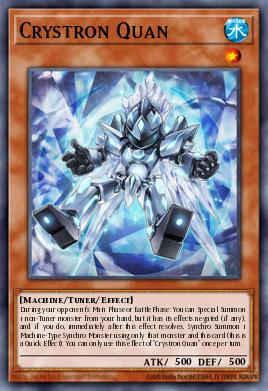
Our first tuner (and arguably the weakest) is Crystron Quan. He's the archetype's level 1 tuner, and during your opponent's main or battle phase, this little guy can synchro summon a machine monster using itself and one other material from the hand. Occasionally useful if you have the relevant non tuner to set up for this little Quartz fellow, but as you'll see shortly, the other tuners are far easier to set up. You'll run at most one copy of Quan, if at all.
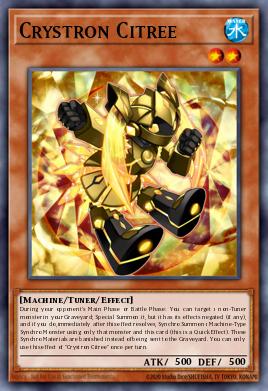 Our second little Citrine friend here is Crystron Citree, and is arguably the most important tuner in the deck. Citree can synchro summon by reviving a non tuner monster from your graveyard, then synchro summoning a machine synchro monster. Both Crystron Citree and the summoned monster are banished in doing so. The one downside to this monster is that like many of the tuners, you don't really want to draw her. Typically a crystron list will play two or three copies of this.
Our second little Citrine friend here is Crystron Citree, and is arguably the most important tuner in the deck. Citree can synchro summon by reviving a non tuner monster from your graveyard, then synchro summoning a machine synchro monster. Both Crystron Citree and the summoned monster are banished in doing so. The one downside to this monster is that like many of the tuners, you don't really want to draw her. Typically a crystron list will play two or three copies of this.
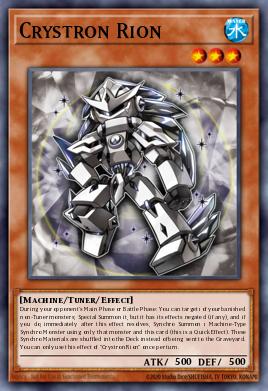
Our last main deck tuner is Crystron Rion. Functionally this monster works the same way as Crystron Citree, but utilising your banished monsters instead, but shuffling both itself and the target into the deck. Theoretically, this could be an infinitely recurring tuner, but we only have so many extra deck spaces. You'll always run at least one copy of this, but you may want to play two in order to ensure you have some grind game.
The Non Tuners
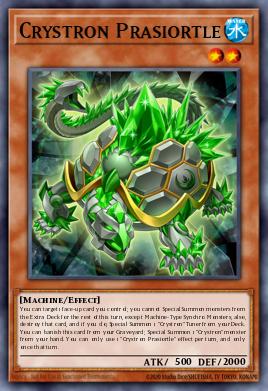 This turtley little fellow is our first non tuner. Like all non tuners, he can summon a crystron tuner from the deck by destroying a card you control. This effect locks you into synchro summoning for the rest of the turn. The second effect of Crystron Prasiortle allows you to banish it from the graveyard in order to special summon another crystron monster from your hand. This can come in useful in a pinch, but typically you'll be using this monster primarily as a level 2 monster for synchro summoning, and little else. Typically run one copy.
This turtley little fellow is our first non tuner. Like all non tuners, he can summon a crystron tuner from the deck by destroying a card you control. This effect locks you into synchro summoning for the rest of the turn. The second effect of Crystron Prasiortle allows you to banish it from the graveyard in order to special summon another crystron monster from your hand. This can come in useful in a pinch, but typically you'll be using this monster primarily as a level 2 monster for synchro summoning, and little else. Typically run one copy.
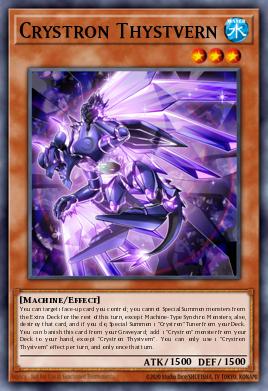 Crystron Thystvern is typically the most important main deck crystron monster - it has the standard first effect, but importantly its second effect allows you to banish it from the graveyard in order to add any other crystron monster from your deck to your hand. Typically you'll be playing cards such as Foolish Burial or a small engine such as the Genex Undine or Scrap Recycler package in order to put this or one of the other strong graveyard effect crystrons into your graveyard consistently. You're almost always playing the maximum number of copies of this card.
Crystron Thystvern is typically the most important main deck crystron monster - it has the standard first effect, but importantly its second effect allows you to banish it from the graveyard in order to add any other crystron monster from your deck to your hand. Typically you'll be playing cards such as Foolish Burial or a small engine such as the Genex Undine or Scrap Recycler package in order to put this or one of the other strong graveyard effect crystrons into your graveyard consistently. You're almost always playing the maximum number of copies of this card.
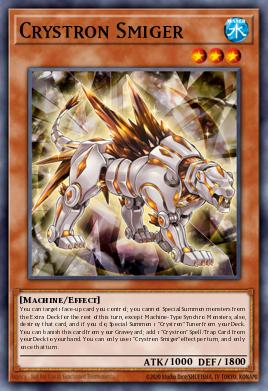 Just... don't pronounce this one like MBT did that one time. Crystron Smiger fills the same role as Crystron Thystvern, but searching the deck for spells or traps instead. We'll get onto this in a moment, but there are no crystron spell cards. Very much a Nekroz of Clausolas situation, so perhaps one day we can hope for the missing Crystron spell card. You'll likely run 2-3 copies of this card.
Just... don't pronounce this one like MBT did that one time. Crystron Smiger fills the same role as Crystron Thystvern, but searching the deck for spells or traps instead. We'll get onto this in a moment, but there are no crystron spell cards. Very much a Nekroz of Clausolas situation, so perhaps one day we can hope for the missing Crystron spell card. You'll likely run 2-3 copies of this card.
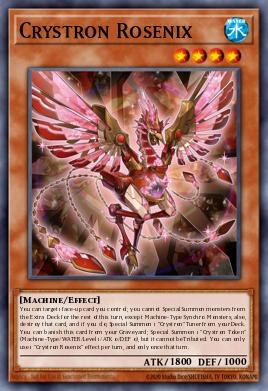 Crystron Rosenix summons a token by banishing itself from the graveyard. Yep, that's it. It's not bad by any means, and actually saw some niche competitive play in other decks through use in Scrap engines and packages that focused on token spam to link climb. Being a level 4 monster can make it a little awkward to synchro climb with, but the token does help. You might run one copy in Crystron builds.
Crystron Rosenix summons a token by banishing itself from the graveyard. Yep, that's it. It's not bad by any means, and actually saw some niche competitive play in other decks through use in Scrap engines and packages that focused on token spam to link climb. Being a level 4 monster can make it a little awkward to synchro climb with, but the token does help. You might run one copy in Crystron builds.
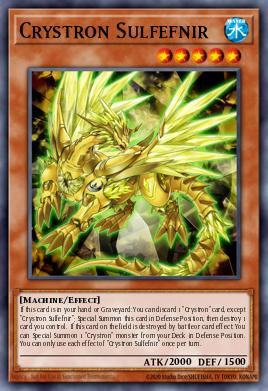 Crystron Sulfefnir is the strange child of the crystron main deck family, differing entirely from the rest of the theme mechanically. This monster can discard a crystron card (not just monster) to special summon itself from either the hand or graveyard, then destroy one card you control. Additionally, this card when destroyed summons one crystron monster from your deck. Unlike the other non tuner monsters, you can use both of these effects per turn, meaning you can summon Crystron Sulfefnir, destroy itself, then summon a crystron monster from your deck. Typically you'll summon your 1-of copy of Crystron Prasiortle, use its effect to destroy itself to summon a tuner such as Crystron Citree, setting up a level 2 in your graveyard to use as synchro laddering fodder.
Crystron Sulfefnir is the strange child of the crystron main deck family, differing entirely from the rest of the theme mechanically. This monster can discard a crystron card (not just monster) to special summon itself from either the hand or graveyard, then destroy one card you control. Additionally, this card when destroyed summons one crystron monster from your deck. Unlike the other non tuner monsters, you can use both of these effects per turn, meaning you can summon Crystron Sulfefnir, destroy itself, then summon a crystron monster from your deck. Typically you'll summon your 1-of copy of Crystron Prasiortle, use its effect to destroy itself to summon a tuner such as Crystron Citree, setting up a level 2 in your graveyard to use as synchro laddering fodder.
The Trap Cards
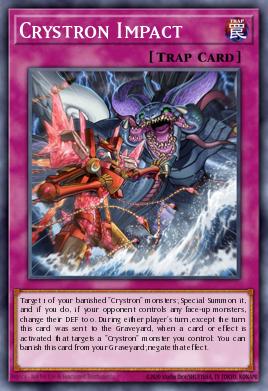
The Crystron theme features two trap cards at time of writing - Crystron Impact and Crystron Entry. Crystron Impact functions as a pseudo revival trap, summoning one crystron monster from your banishment. Typically this will be whatever monster you banished utilising the effect of Crystron Citree, or a monster that got banished by an opponent's effect. As a nice bonus, this card can banish itself from the graveyard in order to protect a crystron monster from a targeting effect. Typically you'll play 2-3 copies of this, due to how easily searchable it is with Crystron Smiger's graveyard effect.
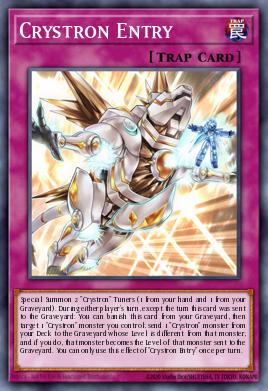
Crystron Entry is a strange card - allowing you to special summon 2 crystron tuners - One from your hand, and one from your graveyard. Note that this is not "up to", so you must have a tuner in both your hand and grave in order to activate and resolve this effect. In theory this is a good effect, however the crystron tuners are not cards you want to draw, making this card at odds with how you want to build the deck. Lastly this card has a graveyard effect that banishes itself in order to send a crystron from your deck to the graveyard to change the level of a crystron monster you control. This is a good effect, but being tied to a trap card's grave effect makes this awkward to utilise well. You might play one copy of this, but most lists don't tend to.
The Spell Card
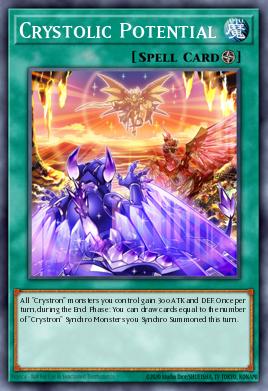 Crystolic Potential is the singular spell card that belongs to the archetype. Note that this card is not a crystron card by name, rendering it unsearchable by the likes of Crystron Smiger. This card simply provides a small boost to your crystron monsters, and draws you cards equal to the number of "crystron" synchro monsters that turn. Arguably it's not an awful effect, but in practice you tend to only summon one or two at most, and only in your opponent's turn, meaning that you are investing this card into a delayed draw 1-2 cards - Which is typically not worthwhile. Most players of this deck tend to opt for Starlight Junktion instead of this card due to the more immediate payoff for synchro summoning.
Crystolic Potential is the singular spell card that belongs to the archetype. Note that this card is not a crystron card by name, rendering it unsearchable by the likes of Crystron Smiger. This card simply provides a small boost to your crystron monsters, and draws you cards equal to the number of "crystron" synchro monsters that turn. Arguably it's not an awful effect, but in practice you tend to only summon one or two at most, and only in your opponent's turn, meaning that you are investing this card into a delayed draw 1-2 cards - Which is typically not worthwhile. Most players of this deck tend to opt for Starlight Junktion instead of this card due to the more immediate payoff for synchro summoning.
The Extra Deck

At time of writing, crystrons have four archetypal synchro monsters, and one link monster. Let's start with Crystron Halqifibrax, being the most infamous card in the theme. Right now this card is banned, primarily from its abuse generically in other decks, which often summoned Mecha Phantom Beast O-Lion to utilise for synchro and link climbing.
In crystrons, you would typically summon this card off Genex Undine, by sending Crystron Rosenix to the graveyard to add Genex Controller to your hand. Following this, you would summon the token off Crystron Rosenix's grave effect, make Link Spider using the token, and summon the genex controller. From this point, you would summon Crystron Halqifibrax and utilise its effect to summon whichever crystron tuner best suits the board and hand state.
In your opponent's turn, Crystron Halqifibrax can banish itself to summon a tuner synchro monster from your extra deck - the main target of which being Crystron Quandax, which we will get to momentarily. An important interaction Crystron Halqifibrax has with the archetype that it belongs to is that Crystron Impact allows you to resummon it from banishment, allowing you to easily reuse its effect to summon synchros for free multiple times.
Due to being banned at time of writing, this card cannot be played in the TCG - But there's always the hope that the card might one day recieve errata in a similar fashion to Summon Sorceress to limit its power level.
Aesthetically, Crystron Halqifibrax is a combination of Crystron Citree, Crystron Rion and Crystron Quan.
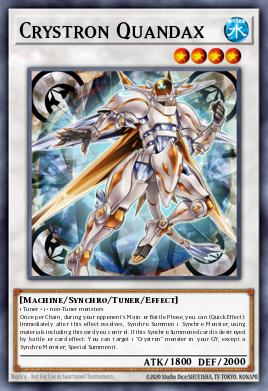
Speaking of synchro monsters summonable off Crystron Halqifibrax's effect - Crystron Quandax is the archetype's themed synchro tuner monster. This monster has the more traditional quick-effect synchro summon effect shared by monsters such as Formula Synchron, allowing you to synchro using monsters you control. Crystron Quandax also allows you to revive a non-synchro crystron monster from your graveyard should it be destroyed - Which naturally can be triggered by the effects of your main deck monsters, should it be neccessary to recover an important tuner monster. You'll typically run at least 1 copy of this monster in a Crystron extra deck.
Aesthetically this monster is also a combination of Crystron Quan and Crystron Smiger.
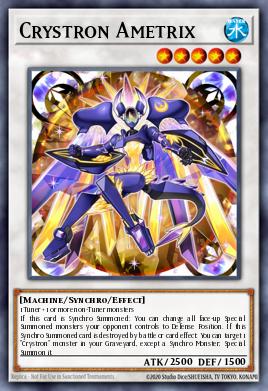 Crystron Ametrix is a level 5 synchro in the Crystron theme, typically functioning as a means to survive one turn kills or ladder into larger synchro monsters. When summoned, Crystron Ametrix changes all monsters your opponent controls to defence position - And can naturally be summoned during your opponent's battle phase through the effects of any of the archetype's main deck tuners. Lastly this monster shares the same ability to float into a monster from the graveyard as Crystron Quandax.
Crystron Ametrix is a level 5 synchro in the Crystron theme, typically functioning as a means to survive one turn kills or ladder into larger synchro monsters. When summoned, Crystron Ametrix changes all monsters your opponent controls to defence position - And can naturally be summoned during your opponent's battle phase through the effects of any of the archetype's main deck tuners. Lastly this monster shares the same ability to float into a monster from the graveyard as Crystron Quandax.
Aesthetically Crystron Ametrix is a combination of Crystron Citree and Crystron Thystvern.
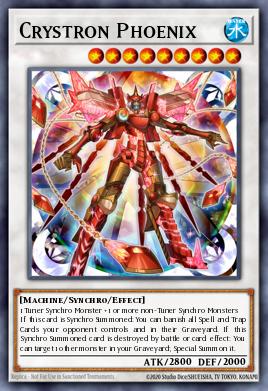 Crystron Phoenix is one of two in-theme boss monsters of the archetype. If this card is synchro summoned, it banishes all spell and trap cards your opponent controls and in their graveyard. There's few things more satisfying than pulling this off against an unaware opponent playing a trap heavy deck. Crystron Phoenix also allows you to summon any monster (unlike the restrictiveness of the smaller synchros) from your graveyard when destroyed. The key difficulty of this monster is that it requires two synchro monsters to summon, which will typically be Crystron Ametrix and Crystron Quandax or similar substitutes. You'll usually play one copy of this card for trap-heavy decks.
Crystron Phoenix is one of two in-theme boss monsters of the archetype. If this card is synchro summoned, it banishes all spell and trap cards your opponent controls and in their graveyard. There's few things more satisfying than pulling this off against an unaware opponent playing a trap heavy deck. Crystron Phoenix also allows you to summon any monster (unlike the restrictiveness of the smaller synchros) from your graveyard when destroyed. The key difficulty of this monster is that it requires two synchro monsters to summon, which will typically be Crystron Ametrix and Crystron Quandax or similar substitutes. You'll usually play one copy of this card for trap-heavy decks.
Aesthetically Crystron Phoenix is formed of Crystron Citree, Crystron Quan and Crystron Rosenix.
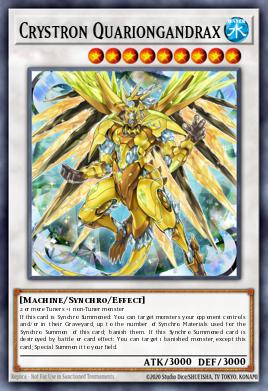
Lastly, Crystron Quariongandrax functions as the most commonly made crystron boss monster - with its effect on summon allowing you to banish monsters from your opponent's field or graveyard equal to the number of materials used for its summon. Note that because this monster requires two tuners, you'll always be banishing at least three cards, functionally making this card an on-theme variant of Trishula, Dragon of the Ice Barrier. When destroyed, this monster allows you to special summon any banished monster (except itself), meaning you can banish an opponent's monster, then destroy Crystron Quariongandrax to summon the monster you banished if you so desire. Due to tight extra deck space in this kind of deck, you'll likely run one copy of this card.
Aesthetically, Crystron Halqifibrax is a combination of Crystron Citree, Crystron Rion, Crystron Quan and Crystron Sulfefnir.
Overall, Crystron are a complex theme to pilot well, requiring a lot of thought and pre-planning in your decision making. Strangely enough, this deck functioned better in the previous master rule, as you could chain together multiple tuner effects such as Crystron Citree to block your own extra monster zone for one of the effects but still bring back a monster from your graveyard. Unfortunately this is no longer possible due to being able to summon synchro monsters to the main monster zones without restriction, but it was a fun interaction.
The theme isn't in the best place right now, but with a competent pilot could perform well enough at a locals level event. Don't expect to see this theme topping major events anytime soon, but many are excited for the prospect of this theme receiving another wave of support due to metalfoes recieving a more modern wave of support focusing around being powered up by absorbing the powers of True King Agnimazud, the Vanisher, becoming Metalfoes Vanisher. It's possible following this line of thought that crystrons might do the same with True King Bahrastos, the Fathomer and eventually the Zoodiac theme might do the same with True King Lithosagym, the Disaster.
If you enjoyed this article and would like to see more, please comment below if there's other themes you'd like to see covered, or if you'd like to see more about techs and decklists for this particular theme!
